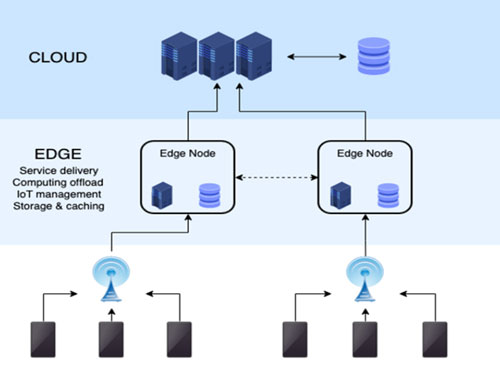Hello!
 Although both edge and cloud computing are new areas in the IT industry. The one with the greatest advantages is the winner.
Although both edge and cloud computing are new areas in the IT industry. The one with the greatest advantages is the winner.
The primary idea of the cloud is to provide a central data source that can easily be accessed from any location on the planet. This seems to be in stark contrast with edge computing’s local information handling concept. Edge computing is, however, a result of the cloud in many ways.
Without central data storage, the big data movement wouldn’t have reached such a large scale. For example, many internet payment providers would cease to exist, and companies such as Amazon and Microsoft would look very different than they do today.
We spent some time trying to find out the advantages of cloud and edge computing. Which one is most efficient? It’s not as easy as you might think.
Cloud computing
 Cloud computing is the storage, processing, and computing of large data sets on remote servers. It also refers to “the supply many Internet-based services such as data storage and servers, databases and networking, as well as software.”
Cloud computing is the storage, processing, and computing of large data sets on remote servers. It also refers to “the supply many Internet-based services such as data storage and servers, databases and networking, as well as software.”
Because data centers are often located far away, there is often a time lag between data collection and processing.
This is usually undetectable for most uses cases. This time latency can be critical for time-sensitive programs. Real-time data collection for self-driving cars is a good idea, as delays can have devastating consequences.
Advantage of cloud computing
 The three main types of cloud computing (SaaS) are infrastructure as a Service (IaaS), platform, and software.
The three main types of cloud computing (SaaS) are infrastructure as a Service (IaaS), platform, and software.
Cloud computing is a form of IaaS. It offers many benefits, including high infrastructure availability, self-service provisioning, elasticity and mobility, workload resilience as well as migration flexibility, wide network access, disaster recovery, and payment-per-use.
Data processing and data transfer can be slowed down by the back-and-forth movement of data between the point of creation and the central server. Emerging technologies and IoT devices have sub-second response times. Therefore, it is important to locate data processing and analysis as close to the source of the data as possible.
Also read: Marketing Tools
Edge computing
Edge computing is a form of cloud computing that brings computation, storage, and networking closer than the data source.
 This reduces travel time and latency significantly. These procedures are performed near the device or at the network’s edges, which allows for faster response times. Edge applications reduce the data to be transferred, the traffic generated by these transfers, and the distance the data must travel.
This reduces travel time and latency significantly. These procedures are performed near the device or at the network’s edges, which allows for faster response times. Edge applications reduce the data to be transferred, the traffic generated by these transfers, and the distance the data must travel.
The Edge Computing Benefits
A shift in the way we gather and analyze data is necessary due to the exponential growth of IoT devices. Think about how many smart home devices you have, then think about how many are used for healthcare, transportation, manufacturing, and other purposes.
It is often more than the network bandwidth that these devices send to their servers. No matter how robust or performant the traditional cloud architectures are, they can’t keep pace with these devices’ current-time needs.
Edge computing is a form of content delivery network (CDNs), which allow organizations to centralize data and service provisioning. However, edge computing uses smart devices or mobile phones to perform tasks for the cloud.
 By reducing data volumes and traffic, edge applications allow for lower latency and lower transmission costs. Edge computing’s content caching and storage capabilities allow for faster response times and higher transfer rates.
By reducing data volumes and traffic, edge applications allow for lower latency and lower transmission costs. Edge computing’s content caching and storage capabilities allow for faster response times and higher transfer rates.
Also read: How to choose The Perfect Domain Name
Who is the winner of this race?
Some observers believe Edge computing may eventually replace cloud computing as computing will become more decentralized, and less need for a central cloud. This will not happen because they have different duties.
 Edge computing devices can quickly capture, process, and analyze data on-site. It doesn’t care about data storage. Cloud computing, however, is built on infrastructure so that it can quickly be expanded to meet different requirements.
Edge computing devices can quickly capture, process, and analyze data on-site. It doesn’t care about data storage. Cloud computing, however, is built on infrastructure so that it can quickly be expanded to meet different requirements.
Edge computing is suitable for applications that require a quick response, while cloud computing is better for more time-sensitive applications. Cloud computing will be complemented by edge computing, rather than replaced.
The obvious benefits of cloud computing are evident. For some applications, however, it is crucial to move activities from the central location to the edge and bring bandwidth-intensive and latency-sensitive apps closer to the user.
It will take some time for mainstream adoption to occur, however, as the process of setting up an edge computing infrastructure requires a lot of professional knowledge.
Thank you!
Join us on social networks!
See you!






